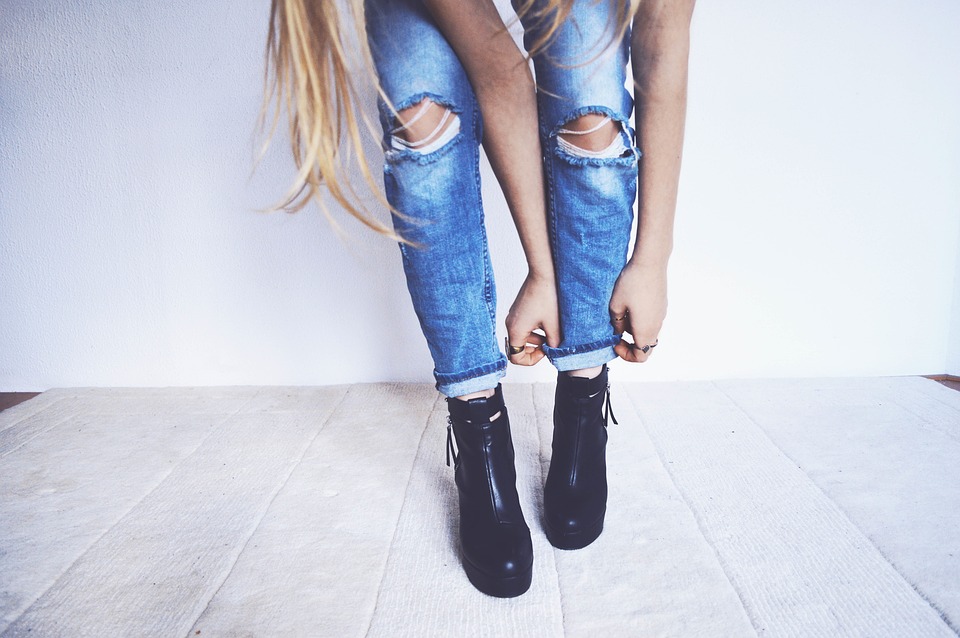When shopping for jeans or other denim products, you may come across some unfamiliar terms. Unfortunately, this can make finding the right denim apparel difficult. If you aren’t familiar with the terms, how can you choose the right product for your needs? Well, we’re going to explore some of the most common denim terms, revealing what they mean and why they are important.
Selvedge Denim
Some premium jeans are often marketed as being made of “selvedge denim.” Contrary to popular believe, selvedge denim isn’t a different type of denim. Rather, it’s characterized by the appearance of finished edges from the loom, usually featured at the bottom of the jeans. When inspecting a pair of selvedge denim jeans, for instance, you’ll probably discover a different color around the ankles. Even if the rest of the jeans are indigo, the bottom few inches of the denim may feature a white color. This contrasting black-on-white color scheme creates a stunning appearance that’s guaranteed to turn heads.
Rise
Denim jeans are typically sold as either low-, mid- or high-rise. The “rise” of jeans refers to the position at which it sits on the waist. Low-rise jeans, for instance, sit low or below the waist. According to Wikipedia, most low-rise jeans sit about 8 centimeters below the naval. In comparison, mid-rise jeans sit right at the waist, offering a balanced medium between low- and high-rise denim. And high-rise jeans sit significantly higher on the waist than both low and mid rise.
Dry Denim
The term “dry denim” shouldn’t be taken literally. Dry denim actually refers to a special type of denim that hasn’t been washed during production. Normally, most denim jeans are washed to make them softer, more comfortable, and to reduce shrinkage. Some manufacturers, however, avoid washing their denim jeans to encourage natural distressing. If jeans aren’t washed, they’ll exhibit characteristic signs of distress due to aging. This includes slight variations in color, natural fading and other imperfections. There’s a strong demand for these naturally distressed jeans, which is why some manufacturers produce and offer dry denim jeans.
Washed Denim
Consequently, “washed denim” refers to denim jeans that have been washed during production. As previously mentioned, denim is often washed during production to make the fabric softer and to reduce shrinkage. Washing denim essentially wears down the fabric to some degree, making it softer and subsequently more comfortable to wear. Washing also shrinks the fabric a small amount — something that we’ve all experienced when doing laundry.
Made-to-Measure Jeans
This term is pretty self-explanatory. Made-to-measure jeans are denim jeans that are customized according to your own body measurements. Normally, most retail and department stores sell jeans in traditional, fixed sizes. Being that no two people have the exact same body shape or size, however, you won’t always find jeans available in your size when shopping at these stores. Therefore, it’s recommended that you order made-to-measure jeans. Available here at MakeYourOwnJeans, made-to-measure jeans allow you to specify your own measurements. You tell us your body measurements, and we’ll use those measurements to create a custom pair of jeans designed specifically for your body. Finding the perfect pair of denim jeans doesn’t get any easier than this!
Stretch Denim
Stretch denim jeans have become increasingly popular and recent years — and for good reason. Unlike traditional denim jeans, they are made with a combination of both denim and an elastic fabric like polyester or spandex. This creates some unique characteristics like increased elasticity and softness that many people prefer over traditional 100% denim jeans. It doesn’t take much elastic fabric to make stretch denim jeans, either. In fact, a typical pair of stretch jeans contain just 3% spandex or polyester, which in turn creates a stretching capacity of roughly 15%.
Indigo Denim
Different types of denim jeans feature different colors. The most common color in which denim jeans are made and sold, however, is indigo. Indigo is characterized by the use of a special type of organic compound with a dark blue color. A typical pair of denim jeans requires between 3 and 12 grams of indigo dye. With its darker appearance, indigo is a popular choice for denim jeans. Generally speaking, darker denim is better suited for semi-formal occasions. This doesn’t necessarily mean that you should wear indigo jeans to a wedding or any other formal event. However, it’s perfect fine to wear them as part of business casual attire, assuming you pair your indigo jeans with the right shirt and shoes.
Whiskers
Have you heard of denim jeans with “whiskers?” Basically, this term refers to the characteristic streaks of fading that form around the crotch area of jeans. Whether they are washed or dry, all denim jeans will inevitably experience some degree of fading. This usually doesn’t happen overnight, but constant use over the course of several months will eventually cause them to fade. When denim jeans become faded, they’ll usually exhibit streaks of discoloration, which are known as whiskers.
Honeycombs
Another denim term you should familiarize yourself with is “honeycombs.” Like whiskers, honeycombs are areas of fading that occur to denim jeans. While whiskers are typically lines, however, honeycombs live up to their namesake by featuring a honeycomb-like design. You’ll usually find these honeycombs around the knees, which is the result of variations in sun/light exposure. Because the back of the knees receive less sunlight than the rest of the jeans, they typically form honeycombs here.
Stacks
Finally, “stacks” refer to areas of natural fading that occur to jeans around the ankles. Denim manufacturers typically don’t produce jeans with stacks. Instead, this fading is created by contact with the shoes. When wearing a pair of denim jeans, for instance, your shoes may hit the bottom of your jeans. Over time, this contact can create patches of fading known as stacks.












